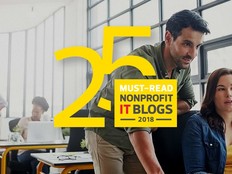Nonprofits Mine Value from Smart Data with Analytics
Thanks to donor databases, email, social media, mobile apps and digital systems for everything from payroll to accounting, nonprofit organizations are awash in more data than ever before. But without the right tools to help sort through it all, this wealth of information can sometimes feel more like a curse than a blessing.
Proper data analytics tools can help nonprofits unlock the value hidden inside seemingly ordinary information scattered across an organization. In particular, analytics can:
- Help nonprofits increase revenue by tapping into their donor base in new ways
- Maximize the value of each interaction
- Help organizations predict which donors are most likely to help them meet their yearly goals
Data analytics solutions can also assist with budgeting and forecasting, planning and analysis, regulatory compliance and global insight.
Organizations looking to leverage the power of analytics will need not only to deploy a data analytics solution, but also to ensure that their computing infrastructure will support it. For some nonprofits, it will make sense to leverage existing on-premises resources. For others, the public cloud will be a better fit.
SIGN UP: Get more news from the BizTech newsletter in your inbox every two weeks!
Nonprofits Can Boost Fundraising with Big Data
Even in the best of times, nonprofits face a major challenge raising funds just to continue operating. In this climate — with competition from other nonprofits, the rise of crowdfunding sites and government funding cuts — staying afloat is an everyday battle. With data analytics solutions, nonprofits can significantly improve fundraising activities, helping them to better optimize their efforts and target donors with individualized outreach strategies.
Anyone who has worked in the nonprofit sector knows well that fundraising isn’t simply a matter of reaching out to as many people as possible and hoping for the best. Organizations must carefully direct their outreach resources toward those most likely to give, find ways to maximize donations without turning off donors and keep givers engaged after their first donation. This process is complicated enough when applied to a handful of high-level donors, and it quickly becomes nearly impossible to manage for an entire organization’s donor list without help from analytics programs.
Small changes in donor outreach — and, by extension, donor behavior — can make all the difference to a nonprofit’s bottom line. For example, only 19 percent of new donors give to a nonprofit again after their first gift, according to the Fundraising Effectiveness Project. But after donors give a second time, their retention rate skyrockets to 63 percent. For many organizations, a data analytics solution that can significantly increase the percentage of donors who give a second time will quickly pay for itself.
Analytics programs can offer a number of measurable benefits to nonprofits. In addition to improving prospect identification and enabling higher contribution levels, data analytics can increase response rates, support stronger relationships with donors, reduce print and mailing costs, and even reduce the direct labor costs associated with fundraising.
Nonprofits must understand the difference between descriptive data (factors such as age, income and wealth status), predictive data (how likely certain donors are to give at certain levels) and prescriptive data (recommendations for certain courses of action).
The value of data analytics tools is that they can make valuable predictions and prescriptions based on a large pool of mostly descriptive information. For example, an analytics program may predict — based on past behavior — that 5 percent of prospects with a net worth of $1 million or more will give at the $25,000 level, helping an organization decide how to use its resources to engage these donors.
There is also significant value to be found in simply cleaning up existing donor record, since some donor addresses are out of date and donor records are often missing phone numbers or email addresses.
Nonprofits Have Several Use Cases for Data Analytics
While fundraising is an obvious application of data analytics solutions for nonprofit organizations, they can also use these tools to achieve many of the same benefits as businesses in other industries. These use cases include:
Budgeting and forecasting: Data analytics solutions can significantly reduce the challenge of managing a nonprofit organization’s budgeting, planning and forecasting processes — no more sorting through dozens of unsynchronized spreadsheets. In addition to creating a central repository of business data, analytics tools help nonprofit leaders plan for the future based on what has happened in the past. For example, an analytics program might reveal trends in donor behavior or the larger economy that signal positive or negative developments for the year ahead. Analytics tools also help organizations centralize and simplify collaboration, enabling complex planning and analysis, and providing integrated reports and scorecards that let nonprofit leaders monitor progress toward their goals in real time.
Regulatory compliance: While most nonprofits do not face the same pressure to protect intellectual property as for-profit businesses do, they still need to protect donor payment data and other sensitive information. Compliance is doubly important for organizations that work in the healthcare sector or manage other personal data. Business intelligence can help organizations gather, organize and analyze data; compile reports; and comply with regulatory requirements.
Improving global insight: Analytics can help organizations gain insights into operational issues such as staffing and asset management. While leaders in large nonprofit organizations can’t have eyes everywhere, a sophisticated and well-managed data analytics solution can help organizations keep tabs on — and optimize — the smallest details, from social media interactions to wasted energy at satellite offices.
Learn more about how data analytics can help nonprofits by downloading the white paper "Using Technology for Good."








